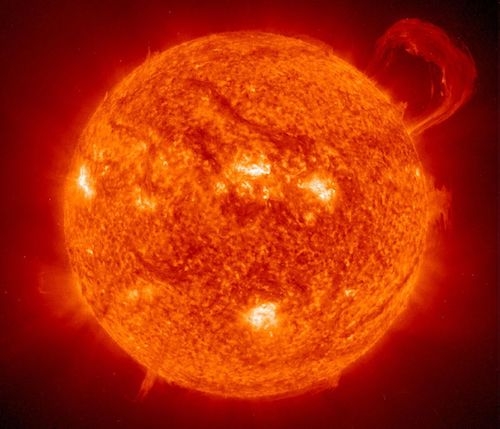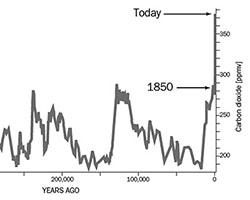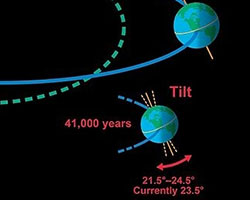show/hide words to know
El Niño-Southern Oscillation (ENSO) Cycle: changes in the temperature of the Pacific Ocean at the equator that causes complex weather patterns.
Milankovitch cycle: long term changes in the Earth’s orbit around the sun.
Natural cycle: a natural process which regulates Earth’s systems.
Solar cycle: changes in the amount of activity on the sun’s surface.
Earth goes through many natural cycles and climate is no exception. Throughout Earth’s history the climate has acted just like a rollercoaster. There have been times when it has been warmer and times when it has been cooler than what it is today. Humans have only been around for about 200,000 years but the climate has been changing for much longer than that. So what might cause climate to change naturally?
Slower Cycles
You may know that Earth orbits the sun in a shape called an ellipse. But the placement of that ellipse doesn’t always stay the same. Milankovitch Cycles describe the changes that happen to Earth's orbit around the sun and how it is tilted on its axis. These cycles occur about every 100,000 years and change the amount of solar energy that reaches Earth’s surface.
When there is less energy, the climate enters a cold cycle and huge glaciers expand across Earth’s surface. The last of these last ice ages ended about 7,000 years ago. When more energy reaches Earth, the climate becomes warmer.
The sun also goes through solar cycles of high and low activity. Although this could affect our climate by changing the amount of energy coming off the sun, scientists have only been able to study the sun with satellites for about 40 years. This makes it hard to know the effects over longer time periods.
Quicker Cycles
Lastly, short term changes in weather can also affect climate. The El Niño-Southern Oscillation (ENSO) cycle causes some years to be really different than usual. During the El Niño phase of ENSO, temperatures of the Pacific Ocean are warmer than usual and global temperatures tend to become hotter. La Niña is the opposite phase of ENSO and global temperatures tend to be cooler.
These two phases can also cause some areas to get more rain and snow and other places to get less. When all the weather is averaged to get the climate, these exceptional events can cause the whole average to become higher or lower.
Visit our links page to find additional resources on climate change.
View Citation
Bibliographic details:
- Article: Natural Climate Cycles
- Author(s): Darin Kopp
- Publisher: Arizona State University School of Life Sciences Ask A Biologist
- Site name: ASU - Ask A Biologist
- Date published: February 2, 2016
- Date accessed: April 17, 2024
- Link: https://askabiologist.asu.edu/natural-climate-cycles
APA Style
Darin Kopp. (2016, February 02). Natural Climate Cycles. ASU - Ask A Biologist. Retrieved April 17, 2024 from https://askabiologist.asu.edu/natural-climate-cycles
Chicago Manual of Style
Darin Kopp. "Natural Climate Cycles". ASU - Ask A Biologist. 02 February, 2016. https://askabiologist.asu.edu/natural-climate-cycles
Darin Kopp. "Natural Climate Cycles". ASU - Ask A Biologist. 02 Feb 2016. ASU - Ask A Biologist, Web. 17 Apr 2024. https://askabiologist.asu.edu/natural-climate-cycles
MLA 2017 Style

Be Part of
Ask A Biologist
By volunteering, or simply sending us feedback on the site. Scientists, teachers, writers, illustrators, and translators are all important to the program. If you are interested in helping with the website we have a Volunteers page to get the process started.











